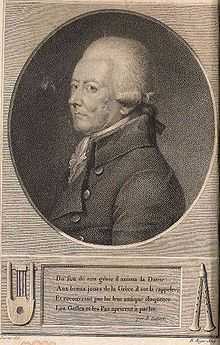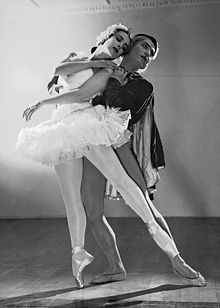Jason et Médée

Jason et Médée (Jason and Medea) is a ballet d'action choreographed by Jean-Georges Noverre to music by Jean-Joseph Rodolphe. The ballet was first staged in the Stuttgart Opera House on Friday, 11 February 1763, in celebration of the Duke of Württemberg's birthday. The plot follows the myth of Jason and the Golden Fleece, and Medea's murder of her children. Jason et Médée was one of Noverre's greatest successes, with unauthorized productions and adaptations mounted for decades across Europe following its premiere.
Background
In 1760, Jean-Georges Noverre recorded his thoughts on dance in Lettres sur la danse, et les ballets with both French and German editions published in Lyon and Stuttgart the same year. He borrowed ideas explored in Vienna by the dancer-choreographer Franz Hilverding, the writer of reform operas Christoph Willibald Gluck and the librettist Ranieri de' Calzabigi who, like Noverre, were seeking a deeper definition of, and credibility for, ballet and opera. Noverre's ideas on dance and performance were well-suited to the new culture in Germany based on the doctrine of emotions and "sensibility" known as Affektenlehre (Doctrine of the affections), and, when an invitation to serve the Duke of Württemberg's court was extended him, Noverre accepted.[1]
The divorced and theatre-loving Karl Eugen, Duke of Württemberg had at his disposal not only the taxes of his 600,000 subjects but some of the most talented theatre artists of the day: the Neapolitan composer and conductor Niccolò Jommelli; the engineer and scenic artist, Giovanni Niccolò Servandoni; the costume designer Louis-René Boquet; and the dancers Jean Dauberval, Charles le Picq, and the brothers Gaetano and Angiolo Vestris. By 1764, Noverre was directing a company of fifteen principal dancers, and a corps of twenty-three men and twenty-one women, mostly trained by himself.[1][2][3]
Composition
For the 1763 celebrations of the Duke's birthday, Noverre choreographed Jason et Médée to music composed by Jean-Joseph Rodolphe as an interlude following the first act of Didone Abbandonate, a twenty-act opera by Jomelli based on the tale of Dido and Aeneas.[2] Jason is a ballet d'action of the heroic type as distinct from the comic, exotic, or fantastic ballet d'action,[4] and was first staged in the 4000-seat Stuttgart Opera House on 11 February 1763.[1][5][6] Noverre's ballet was complete in itself but supported, echoed, and furthered the action, drama, and emotion of Jomelli's opera.[1][5]
Like other artists of his age, Noverre was probably influenced by Horace's Ars Poetica, a manual of aesthetics referenced in Europe since the Renaissance. In his treatise, Horace cautions poets and painters against depicting monstrous or fantastic aberrations of nature such as Medea's slaughter of her children. Noverre was keenly aware of problems of decorum and suitability, and, resisting conventional conservatism, pushed his works from their early academic character to one of picturesquely vivid and plastic pantomime with the English actor, David Garrick, his stylistic ideal.[4] In spite of working and writing for fifty years, Noverre made little headway against the reigning conservatism of the age, and was castigated for his fussy, over-elaborate pantomime.[5]
Antecedents
The story of Jason and Medea was familiar in many dramatic treatments in France, beginning with Pierre Corneille's version of Euripides in 1635. As early as 1454 however, the myth was presented as a dumb show in Lille, and, in 1489, the dancing master Bergonzio di Botta of Tortona adapted the tale of the Argonauts to a version that then became a model for subsequent danced entries in a variety of styles and tastes. In 1736, Marie Sallé, a dancer much admired by Noverre, danced the role of Medea in a version called Médée et Jason.[4]
Plot summary
The ballet is based on the myth of Jason and the Argonauts, and the hero's encounter with the sorceress Medea. Jason, in order to regain his throne from his usurper-uncle Creon, ventures forth with his companion Argonauts to find the Golden Fleece. The precious object becomes his when a powerful sorceress named Medea helps him conquer the dragon guarding it Jason has two children by Medea, but he abandons her for the nymph Creusa. Medea sends the nymph a poisoned mantle whose fire consumes her, and then, in a jealous rage, kills her own children.[5]
Production details
Medea was portrayed by the English ballerina Mlle. Nency who "apart from her amazing dance talent, succeeded by showing in her acting ability all the soul and expression of that incomparable actor, the celebrated Garrick, in England where the dancer, trained by Mr. Noverre, was born."[5] Other terpsichorean roles included Fire (Medea's burning mantle), Steel (Medea's Sword of Vengeance), and Jealousy. Gaetano Vestris (who had travelled from Paris especially for the occasion) and Angiolo Vestris were Jason and Créon respectively.[3][5]
Reception
When the wild-eyed Furies first appeared on stage in the ballet, some audience members reportedly fainted while others fled the theatre.[5] In 1780, a Paris libretto described the work as a "Ballet Terrible, ornamented by dancing, suspicion, darkness, pleasure, horror, poison, tobacco, dagger, salade ('hodge-podge'), love, death, assassination, and fireworks."[5] The ballet was one of Noverre's greatest success, and was constantly revived across Europe in the decades following the ballet's premiere with or without acknowledgment of Noverre's authorship or his supervision.[4][note 1][1][7]
References
- Notes
- ↑ Gaetano Vestris (Noverre's first Jason) was the dieu de la danse of the period, and freely appropriated and adapted Noverre's Jason all over Europe. As a consequence, Noverre blamed Vestris for the poor reception his five-act version of the ballet received at the Paris Opéra in 1780. In 1781, Vestris appeared in his adaptation of Jason et Médée in London without acknowledging the original author of the work.
- Footnotes
- Bibliography
- Foster, Susan Leigh (1998) [1996], Choreography and Narrative: Ballet's Staging of Story and Desire, Bloomington: Indiana University Press, ISBN 0-253-33081-5
- Kant, Marion (2007), The Cambridge Companion to Ballet, Cambridge and New York: Cambridge University Press, ISBN 978-0-521-53986-9
- Kirstein, Lincoln (1984), Four Centuries of Ballet: Fifty Masterworks, New York: Dover Publications, Inc., ISBN 0-486-24631-0
- Lee, Carol (2002), Ballet in Western Culture, New York and London: Routledge, ISBN 0-415-94256-X
- Lynham, Deryck (1950), The Chevalier Noverre: The Father of Modern Ballet, London: Sylvan Press
| ||||||||||||||||||||||||||||||||||||
| ||||||||||||||||||||||||||||||||||||||
| ||||||||||||||||||||||
